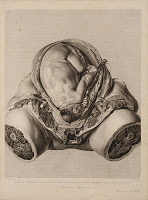Welcome back to the Dittrick Museum Blog! Last week, we discussed some of the finer points of birth anomaly in the 18th century. Today, we will consider the ways in which Paré’s work influenced the writers of the nineteenth century!
As the Age of Enlightenment, the eighteenth-century promoted scientific and philosophical progress. By the latter part of the century, causation (in reproduction but also in relation to disease) had largely left Pare’s metaphysical behind in medical treatises—but it enjoyed renewed fervor in the popular press. Two broad categories of work regularly printed stories of monster birth. The first were collections...
Medical History
Last week, I introduced the "monsters and marvels" of Ambroise Paré. This unique text is not a collection only (or even primarily) of cases witnessed by the good doctor. Such treatises also existed, and became more popular over time. Both Dr. William Smellie and Dr. William Hunter published extensively about their practices, and many doctors described difficult labors or unusual births. Paré's 15th century text is, however, much more a compendium; he collects tales from afar, gathers anecdotes from ancient manuscripts and compiles accounts from myth and local legend. Parts of the book actually discuss strange animals from foreign...
Monsters are things that appear outside the course of Nature (and are usually signs of forthcoming misfortune).--Ambroise ParéWelcome back to the Dittrick Museum Blog!Last week, we discussed the "curious machine" of man-midwife Dr. William Smellie. This week, I will introduce Ambroise Pare and the birth of "monsters." The images that Dr. Parécollected in Des Monstres et prodigies(1573) continued to fire the imagination well into the 18th and 19th centuries, a time that witness the "birth" of Gothic monsters, as well. The Dittrick's collection includes a fine edition of this work, and it is replete with fascinating images, some of which...
Last week, I discussed the unusual nature of William Smellie's "celebrated apparatus," or mechanized obstetrical phantom. Today, I will continue with part two, where I give contemporary physician Peter Camper's laudatory description--and discuss the woman-machine's vanishing act. --Brandy Schillace
________________________________________
After attending Smellie’s lectures, he described the “contraction of both the internal and external os, the generation of water in parturition and dilatation of the os uteri are so natural that hardly any difference is to be noticed between these, and those in natural women.” From Camper, a physician and surgeon certainly aware of actual anatomy, such a claim is...




